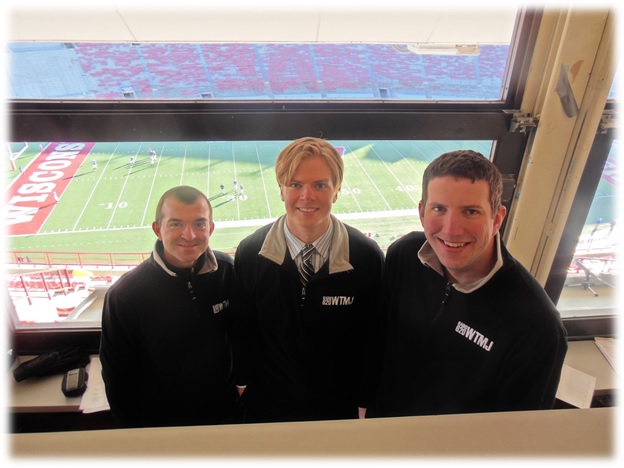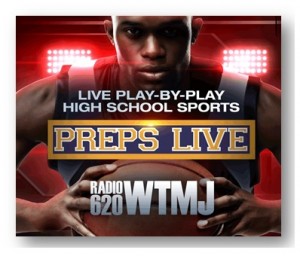One of the great puzzles many local-minded stations have struggled to solve is how to effectively cover high school sports. The games represent incredible, hyper-local content that attract sponsors who want to be a part of them. They can be an incredibly rich source of community involvement for stations in the Talk/Sports environment.
The challenge is that they appeal to a limited audience and they take place at essentially the same time. This makes covering high school sports difficult and expensive. And so some good old innovation was used employed to attack the problem.
This past fall, Journal/Milwaukee News/Talk WTMJ launched “Preps Live,” a program that melds today’s technology with the promotional power of a heritage radio station to effectively cover multiple football or basketball games each week without disrupting the station’s regular programming.
As Tom Langmyer, VP/GM of WTMJ-AM and WLWK-FM and Journal’s VP of News/Talk, explains in this edition of Radio’s Most Innovative, this unique coverage of high school sports helps market the station and reinforces its brand while also generating revenue.

JM: Can you explain how “Preps Live” works?
Tom: “Preps Live” is our group of digital stations for covering high school sports. They are part of our RadioLeague platform which is populated with Journal’s over the air stations, plus 19 digital pure-play stations.
Part of what we are developing with RadioLeague is “Go-Live” technology that enables us to broadcast from anywhere using simple equipment set-ups and inexpensive data services. “Preps Live” and “Preps Live 2” are part of that.
What makes it possible is the availability of high-speed wireless connections. That enables us to have great sounding audio without the expense and hassle of ISDN. At the games, we simply use a laptop with an audio mixer and a 4G card to go live.
 JM: Whose idea was this and what was the inspiration?
JM: Whose idea was this and what was the inspiration?
Tom: This was truly a group effort. J. Pat Miller, our recently minted director of marketing & innovation at WTMJ, has been building the RadioLeague site and app. Michael Gay, our Interactive VP, led the conception and design of our WISports.com site, which covers the Packers, Brewers, Bucks, and Badgers. And a group of us, including me, helped build a number of digital pure-play stations for the RadioLeague platform. Putting all of it – “Preps Live,” WISports.com, and Radio League — under the huge WTMJ umbrella helps power the products, building awareness and audiences.
The inspiration comes from our mission to create great, unique, local content. Since some of us started in college and small town radio many years ago, we recognize the power and connection those local stations had, and still have, in their communities. Most large and major market stations don’t get that but that fire still burns here. WTMJ is committed to live and local content and is an AM radio-based brand that is actually growing because of our increased focus on building our local connection. We’re not in the relay business. We’re in the content business.
JM: What were the biggest challenges you faced in implementing this plan? How did you overcome them?
Tom: Our challenge was to have a professional sounding game presentation, and have all production elements and spots ready to go for one person to run with at a game. We use three pieces of software on an LTE card that streams to a server inside the Radionomy platform. Radionomy’s support team did a great job guiding our people through it all. It sounds good!
JM: How much of an investment was required in equipment and personnel?
Tom: Each full broadcast setup costs about $3,000. The “Preps Live” program is run by Doug Russell, who is executive producer of sports at WTMJ. He has a crew of 4-5 independent broadcasters and some analysts that do the games.
JM: Did the sales team see the value immediately or did it take time?
Tom: WTMJ has a long history of broadcasting sports, so our team understands how to sell the content. We already have a great roster of sponsors, including a local supermarket chain, and the program is profitable. I wouldn’t recommend this to a solely ratings-based or transactional sales organization though.
JM:

What level of involvement is required from the schools? Was there any pushback?
Tom: The schools are very excited that WTMJ, which is “Wisconsin’s Radio Station,” is coming to call their games. We make it easy for schools, because we just need a power plug. We handle the connectivity. Our human connection with the schools is positive since we work with them to get the word out on special things they’re doing by interviewing the athletic director, principle, coaches, and others during the halftime show.
JM: How do you promote the broadcasts? Do the schools help spread the word?
Tom: We use WTMJ Radio, WTMJ.com and WISports.com to drive audiences to the games. We also have an advance team that contacts every school to share pre-made broadcast posters and sample social media posts. Our team also activates the schools and their supporters on Twitter using @prepslive before and during the games.
JM: Do you think there are further opportunities to build other hyper-local streaming products like this?
Tom: Absolutely. Now that we can create an unlimited amount of radio stations and go live anywhere, the opportunities are limitless.
JM: Are there other areas of the industry where you think radio should be focused on innovation?
Tom: Innovation is critical but “Preps Live” isn’t as much about the technology as it is about great local content. The biggest innovations involve the best content creators. We simply amplify their message using all of the tools we have today. The tools aren’t the issue – It’s about working with people who create desirable content.
JM: Is there another innovation – in the industry or not – that has caught your attention lately?
Tom: I like to see innovations in the world of news coverage and video. For example, Lee Abrams is working on some neat things with his TouchVision product. And personally, I’m fascinated by drones, 3D printing, and some other fun stuff like that.
JM: What suggestion would you give to someone with an innovative idea that is having a hard time getting traction?
Tom: Most great innovations start at “eye level.” They make life easier and or more interesting. Where great innovators lose traction is missing the business part. Partner with a great business person who can pull a business plan together with a strong sales and marketing element. In the end, the idea still needs to be something new and different, but it also has to be desirable to a real target consumer and make business sense.
Thanks to Mike Stern for writing this week’s Radio’s Most Innovative article.
INNOVATION QUOTE OF THE WEEK:
“Calculated risks are part of what you do, but the idea that something completely crazy will work just because it’s completely crazy is completely crazy.”
Bill Walsh, NFL Coach
Check out some of our “Past Innovators” here:
- December 5 Jerry Lee/WBEB
- December 12 Rockline
- January 9 Dan Vallie/National Radio Talent System – Part 1
- January 16 Dan Vallie/National Radio Talent System – Part 2
- Media And Technology In 2025: Believe It Or Not! - April 18, 2025
- In Radio, You Just Never Know - April 17, 2025
- The Secret To Making A Great Podcast (And Great Radio) - April 16, 2025





Very cool. Hmmm….And there’s a business opportunity here. Someone could set up a national network based on this model. X number of setups per market, based on market size and number of high schools – and bulk purchases could bring the price per unit down below $3K. Bigger games could also include video – live or at least highlights.
Whoever set this up could partner with a radio or TV station in each market who would have branding rights. The station who would also do the ad sales on with a revenue split and promo time guarantee. If an equipment manufacturer was an investment partner, there could be a built in profit on hardware sales with no negative impact to the business model. $30-$60K per market start up cost, depending on market size meaning $-5 million would be enough to put a nice footprint in the top 100 markets.
An average of $10K net profit per market (conservatively on $15K in sales – more in big markets less in smaller ones – one sponsor might be enough if they got branding on everything including promos) net would throw off $1 million in cash, or between 20 and 25%. After the first year those margins would be 2 to 3 times that.
Just a thought…
And a good one. Nice to see those revenue wheels turning, Bob. And beyond the money, the perceptual, local, branding value is immense. As noted, I also love the fact that you’re reaching many parents/grandparents on a very personal, emotional level that is all about family. Not to mention, a chance for radio to connect with kids. Thanks for the well-calculated email.